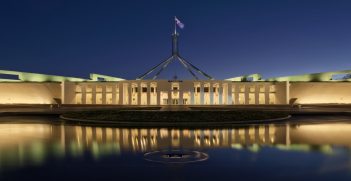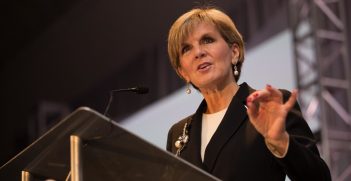The Room Where It Happens: Girls Run The World

The Girls Run The World (GRTW) program facilitates young women completing placements in diplomatic missions across Canberra. It seeks to address the critical underrepresentation of women in diplomacy.
GRTW has come a long way since it was first dreamed up by Asha Clementi following Plan International’s Takeover of Parliament back in 2017. The next year, she self-admittedly “snuck in” to a United Nations Security Council meeting while representing the National Council of Women Australia at the United Nations Commission on the Status of Women, and thought to herself, “where else will they let me in if I just ask?”
Last month, 30 participants, all young women aged 18-25, headed off to 13 diplomatic missions, including Canada, the Netherlands, and the United States. The program offers a unique and elegant solution to a perennial issue in diplomacy – the fact that women are still underrepresented in the field. By facilitating women to “take over” a diplomatic mission for a day or two, participants forge relationships with high-level representatives, participate in diplomatic discussions and debates, and may even begin to see a future career in diplomacy as a genuine possibility. For many young people, the world of diplomacy – of embassy events, ambassadors, multilateral fora – can be overwhelming and intimidating. For young women, this is often even more so.
It is worth noting that in recent years, Australia has managed to significantly increase the representation of women in senior diplomatic and foreign policy roles. Julie Bishop was appointed as Australia’s first female minister for foreign affairs in 2013, and following her resignation, Marise Payne was appointed to the role. Kathryn Campbell has followed in Frances Adamson’s footsteps as secretary of the Department of Foreign Affairs and Trade (DFAT). The shift toward greater representation has been particularly effective in the past six years, since DFAT first launched its Women in Leadership Strategy. However, despite this push, there has still never been a woman ambassador or high commissioner to some of Australia’s biggest overseas postings, including London, Washington DC, Jakarta, and Tokyo.
What the Women in Leadership Strategy has shown, though, is that progress in this space can, and is, being made. As of 2021, women comprised 49 of the 118 heads of Australian missions overseas. But the strategy’s success has also demonstrated that increasing the representation of women in diplomacy requires an ongoing, concerted effort, and that this task is not over yet.
However, ensuring that women are equally represented in diplomacy does not begin within DFAT. It begins much earlier than this, when girls and young women are deciding what career path they may wish to consider; when they choose their university degree; when they sit in their first “Introduction to International Relations” lecture. It continues when young women are first spoken over in a tutorial by an opinionated male peer, when they realise that all of their tutors and lecturers are male, or when they notice that not a single one of their compulsory university readings feature a woman author. They may even attend an embassy event in Canberra and be asked if they are the daughter of a diplomat, rather than an attendee in their own right.
A recent Australian study conducted on Model United Nations simulations at universities found that women participate less, feel less included, and feel less confident than their male peers. It is in this formulative time that women may feel that diplomacy and international relations “just isn’t for them,” that they can’t see themselves going down this career path.
GRTW steps in at this crucial time. It invites young women into the very buildings where some of the biggest diplomatic decisions in Australia are made – to quite literally be in the room where it happens. Participants in GRTW’s programs are exposed to the reality of the diplomatic world and introduced to ambassadors and high commissioners. They might have the opportunity to take over the embassy’s social media for the day, or plan the agenda for an upcoming business delegation. They might even spearhead discussions around gender representation in diplomacy. By including young women in these discussions, even for a day or two through a program like GRTW, they begin to see themselves as future diplomats and leaders. Participants gain confidence, develop genuine connections with diplomatic staff and heads of missions, and are often invited back for events well beyond their placement period.
There is, of course, enormous value in the program for diplomatic missions, too. Including the perspectives of young women in their work can offer novel solutions and the chance to consider issues from a different angle. It also allows diplomatic officials to closely engage with the community that they are posted to and better understand a wider variety of Australian perspectives. Moreover, including women in diplomacy more generally has its own tangible benefits. Indeed, the chief of UN Women, Phumzile Mlambo-Ngcuka, has famously said that women are “perhaps the most under-utilised tool we have for building peace.” Similarly, women’s participation in peace negotiations contributes to the “quality and durability of peace after civil war.”
More actively seeking to engage young women in international affairs and diplomacy benefits not only the women involved, but diversifies debate and discussion on foreign policy issues. Programs like GRTW are helping to shape the future of Australia’s diplomatic corps. Changing norms and expectations around what participants in diplomacy look like doesn’t begin in DFAT – it begins long before stepping foot in the RG Casey Building. Acknowledging this and acting earlier to encourage and facilitate women to consider and pursue careers in diplomacy are essential to ensuring that women make up at least half of the next generation of Australian diplomats. It is only then that Australia will have the diplomatic corps it needs to tackle global challenges in an increasingly complex world.
Isabella Keith is a weekly columnist for Australian Outlook. She is also an undergraduate student at the Australian National University studying Law and Politics, Philosophy and Economics. Isabella’s research interests include international law and comparative constitutional law.
This article is published under a Creative Commons License and may be republished with attribution.





